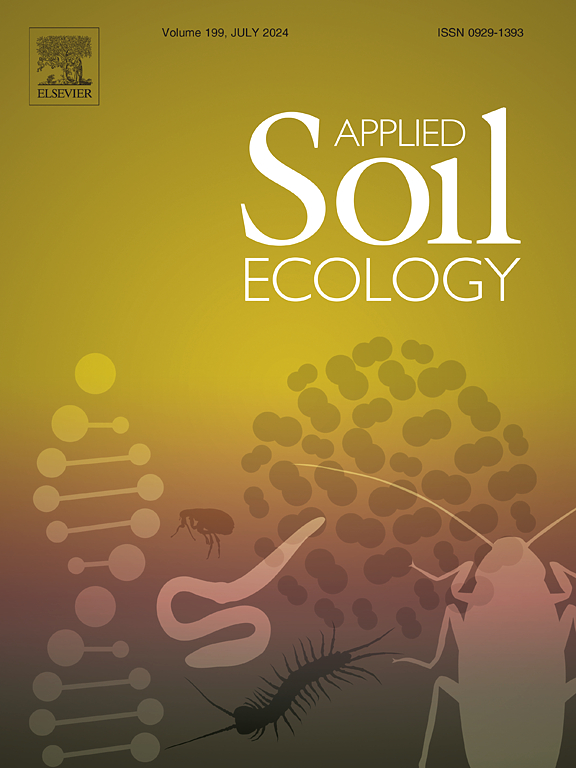不同的保护机制驱动了连续施用生物炭和无机肥水稻土功能碳库的变化
IF 5
2区 农林科学
Q1 SOIL SCIENCE
引用次数: 0
摘要
生物炭改性被认为是水稻土固碳的一种有效方法。然而,生物炭对土壤功能碳库的影响及其潜在机制尚不清楚。为了解决这一问题,从2017年到2022年进行了为期六年的田间试验,涉及四种处理:不施用无机肥料或生物炭(对照),仅施用无机肥料(NPK);生物炭(biochar);无机肥料和生物炭(NPKB)的联合使用。研究了0 ~ 15 cm和15 ~ 30 cm两个土层的功能碳库分布、土壤有机碳(SOC)结构和微生物群落。结果表明:施用生物炭可显著提高土壤表层(92 - 763%)和底土(34 - 290%)的有机碳含量,其中90%以上的新增有机碳集中在颗粒有机质(POM)库中;相比之下,无机施肥对表层土壤碳库没有影响,但增加了除fPOM外的各种地下碳库0.3 ~ 5.7 g kg−1。无机施肥和生物炭的加性效应主要表现在底土,特别是POM池。此外,添加生物炭显著提高了表层土壤和底土的有机碳芳香性(37.3%),其中NPKB处理的总磷脂脂肪酸(PLFA)丰度最高,分别比其他处理高42 - 118%和209 - 258%。冗余分析和Mantel检验表明,土壤有机碳结构、土壤养分和总PLFA是影响功能碳库分布的主要因素。偏最小二乘路径模型进一步表明,添加生物炭通过影响有机碳结构调节表层土壤碳库分布,而无机施肥通过塑造底土微生物群落结构影响表层土壤碳库分布。综上所述,生物炭与无机肥料联合施用具有增强水稻土底土固碳的潜力。本文章由计算机程序翻译,如有差异,请以英文原文为准。
Diverse protective mechanisms drive changes in functional carbon pools of paddy soil under continuous biochar and inorganic fertilizer application
Biochar amendment is believed to be an effective practice for organic carbon sequestration in paddy soil. Nevertheless, the influences of biochar on soil functional carbon pools and the underlying mechanisms remain poorly understood. To address this, a six-year (from 2017 to 2022) field trial was implemented involving four treatments: no application of inorganic fertilizers or biochar (Control), inorganic fertilizers alone (NPK); biochar alone (Biochar); and joint use of inorganic fertilizers and biochar (NPKB). The distribution of functional carbon pools, soil organic carbon (SOC) structure, and microbial community were investigated in two soil depths (0–15 cm and 15–30 cm). Results showed that biochar application led to obviously higher organic carbon in unprotected and physically protected pools in the topsoil (92–763 %) and subsoil (34–290 %), with over 90 % of the additional SOC concentrated in particulate organic matter (POM) pools. By contrast, inorganic fertilization did not affect topsoil carbon pools but enhanced various subsoil carbon pools (except fPOM) by 0.3–5.7 g kg−1. The additive effect of inorganic fertilization and biochar addition was primarily recorded in the subsoil, especially in the POM pools. Furthermore, biochar addition significantly increased SOC aromaticity in the topsoil (373 %) and subsoil (203 %), while NPKB resulted in the highest total phospholipid fatty acids (PLFA) abundance, 42–118 % and 209–258 % greater than other treatments in the topsoil and subsoil, respectively. Redundancy analysis and Mantel test indicated that SOC structure, soil nutrients and total PLFA were the primary factors influencing the distribution of functional C pools. Partial Least Squares Path Modelling further demonstrated that biochar addition regulated topsoil carbon pool distribution by influencing SOC structure, while inorganic fertilization affected it by shaping microbial community structure in the subsoil. Overall, the joint application of biochar and inorganic fertilizers holds potential for enhancing subsoil carbon sequestration in paddy soils.
求助全文
通过发布文献求助,成功后即可免费获取论文全文。
去求助
来源期刊

Applied Soil Ecology
农林科学-土壤科学
CiteScore
9.70
自引率
4.20%
发文量
363
审稿时长
5.3 months
期刊介绍:
Applied Soil Ecology addresses the role of soil organisms and their interactions in relation to: sustainability and productivity, nutrient cycling and other soil processes, the maintenance of soil functions, the impact of human activities on soil ecosystems and bio(techno)logical control of soil-inhabiting pests, diseases and weeds.
 求助内容:
求助内容: 应助结果提醒方式:
应助结果提醒方式:


